Experimental and Numerical Simulation Study on the Mechanism of Fracture-Increasing and Permeability-Increasing in Granite Pore Walls by the Air DTH Hammer Percussion Drilling
Abstract
:1. Introduction
2. Experimental Methodology
2.1. Percussion Drilling Test
2.1.1. Granite Sample
2.1.2. Impact Specimen Processing
2.1.3. Percussion Drilling Equipment
2.1.4. Percussion Drilling Test Process
2.2. Percussion Crack Identification
2.2.1. Dyeing Experiment
2.2.2. CT Scan Recognition
2.3. Mechanical and Permeability Experiments
2.3.1. Mechanical Test
2.3.2. Permeability Measurement
3. Results and Discussion
3.1. Analysis of Fracture Distribution around the Wellbore
3.2. CT Analysis
- The three-dimensional length distribution of pores ranges from 0.06 to 2.38 mm, with pores smaller than 0.2 mm accounting for approximately 81% of the total number, and the number of pores shows a significant decreasing trend with the increase in three-dimensional length.
- The three-dimensional width distribution of pores ranges from 0.06 to 1.36 mm, with pores less than 0.15 mm accounting for about 93% of the total number, and the number of pores shows a significant decreasing trend with the increase of three-dimensional width.
- The equivalent diameter distribution of pores ranges from 0.06 to 0.91 mm, with pores ranging from 0.05 to 0.15 mm accounting for approximately 94% of the total number. The number of pores decreases significantly with the increase in equivalent diameter.
- The volume distribution of pores ranges from 0.00016 to 0.4 mm3, with pores with a volume less than 0.01 mm3 accounting for over 99%. Among pores with a volume greater than 0.015 m3, 85% are pores with a volume between 0.015 and 0.06 mm3. After a volume greater than 0.04 mm3, the number of pores decreases sharply.
- After drilling experiments, the porosity of the granite block increased from 0.0025% to 0.03%, and the porosity increased by about 12 times.
3.3. Analysis of Mechanical Test Results
3.3.1. Uniaxial Compression Test
3.3.2. Permeability Testing
3.4. Numerical Analysis of Impact Stress Waves
3.4.1. PFC3D-GBM Establishment Method Based on the Real Mineral Composition of Granite
3.4.2. Simulation Process
3.4.3. Simulation Result Analysis
4. Conclusions
- The dyeing test and CT results indicate that air DTH hammer drilling can increase wellbore cracks, and the distribution of cracks has a regional feature. Microcracks are distributed from near to far on the borehole wall and bottom, mainly related to the attenuation of impact stress waves. According to the analysis of the three-dimensional reconstruction results, the porosity of the granite block has increased from 0.0025% to 0.03%, and the porosity has increased by about 12 times.
- The results of mechanical and permeability testing experiments show that the air DTH hammer impact drilling process can reduce the strength of granite around the hole wall and increase porosity and permeability. The average strength of the granite has decreased by 16.5%, from 148.65 MPa to 124.81 MPa. The porosity has increased by 9.5%, from 1.127% to 1.234%. The permeability rate increased by 63.3%, from 0.0546 mD to 0.0891 mD. This further verifies the feasibility of this process for increasing permeability in geothermal mining.
- The numerical results are consistent with the experimental results. The results indicate that over time, the energy of stress waves decreases with the distance from the impact location, and the energy propagates faster along the impact direction compared to perpendicular to the impact direction. The failure of the rock mass also exhibits a regional pattern. The stress wave area in the simulation results agrees with the experimental crack distribution area, revealing the rationality of crack zoning distribution in the experiment.
- The next step is to study the air DTH hammer drilling mechanism to create fractures and increase permeability in thermal storage environments (high temperature and pressure). By changing the parameters of impact drilling, more impact fractures can be obtained to assist in developing and utilizing geothermal resources.
Author Contributions
Funding
Data Availability Statement
Conflicts of Interest
References
- Geertjan, O.; Bob, H.; Volkert, R. From gas to geothermal, an overview from the Netherlands. In Proceedings of the World Geothermal Congress 2020+1, Reykjavik, Iceland, 24–27 October 2021. [Google Scholar]
- Inga, M.; Rolf, B.; Josef, W. The energy transition from fossil fuels to geothermal energy–A German case study. In Proceedings of the World Geothermal Congress 2020+1, Reykjavik, Iceland, 24–27 October 2021. [Google Scholar]
- Kumari, W.; Ranjith, P.; Perera, M.; Li, X.; Li, L.; Chen, B.; Isaka, B.A.; De Silva, V. Hydraulic fracturing under high temperature and pressure conditions with micro CT applications: Geothermal energy from hot dry rocks. Fuel 2018, 230, 138–154. [Google Scholar] [CrossRef]
- Tester, W.; Anderson, J.; Batchelor, S. The Future of Geothermal Energy–Impact of Enhanced Geothermal Systems (EGS) on the United States in the 21th Century; Massachusetts Institute of Technology: Boston, MA, USA, 2006. [Google Scholar]
- Pang, Z.; Kong, Y.; Shao, H.; Kolditz, O. Progress and perspectives of geothermal energy studies in China: From shallow to deep systems. Environ Earth. Sci. 2018, 77, 580. [Google Scholar] [CrossRef]
- Xu, T.F.; Hu, Z.X.; Li, S.H.; Jiang, Z.J.; Hou, Z.Y.; Li, F.Y.; Liang, X.; Feng, B. Enhanced geothermal systems: International research progress and research status in China. Acta Geol. Sin. 2018, 92, 1936–1947. [Google Scholar]
- Huang, W.; Cao, W.; Li, T.; Jiang, F. Numerical simulation and economic analysis of heat recovery system of thermal gravity heat pipe in dry hot rock. Acta Chemolog. Sin. 2021, 72, 1302–1313. [Google Scholar]
- Jeanne, V.; Albert, G.; Carole, G.; Régis, H.; Nicolas, C.; Clément, B. Temperature signature of permeable fracture zones in geothermal wells of Soultz-sous-Forêts in the Upper Rhine Graben. GRC Trans. 2018, 42, 18. [Google Scholar]
- Zhou, Z.; Jin, Y.; Zeng, Y.; Youn, D. Experimental study of hydraulic fracturing in Enhanced Geothermal System. In Proceedings of the 52nd US Rock Mechanics/Geomechanics Symposium, Seattle, WA, USA, 17–20 June 2018; American Rock Mechanics Association: Seattle, WA, USA, 2018. [Google Scholar]
- Lepillier, B.; Daniilidis, A.; Doonechaly Gholizadeh, N.; Bruna, P.O.; Kummerow, J.; Bruhn, D. A fracture flow permeability and stress dependency simulation applied to multi-reservoirs, multi-production scenarios analysis. Geotherm. Energy 2019, 7, 24. [Google Scholar] [CrossRef]
- Lepillier, B.; Yoshioka, K.; Parisio, F.; Bakker, R.; Bruhn, D. Variational Phase-Field Modeling of Hydraulic Fracture Interaction with Natural Fractures and Application to Enhanced Geothermal Systems. J. Geophys. Res. Solid Earth 2020, 125, e2020JB019856. [Google Scholar] [CrossRef]
- Glowka, A.; Schafer, M.; Wright, K.; Whitlow, L.; Bates, W. Status of Lost Circulation Research. In Proceedings of the Transactions, DOE Geothermal Program Review XI, Berkeley, CA, USA, 27–28 April 1993; Available online: https://www.osti.gov/servlets/purl/10160249 (accessed on 7 February 2024).
- Pollack, A.; Horne, R.; Mukerji, T. What are the challenges in developing enhanced geothermal systems (EGS) observations from 64 EGS sites. In Proceedings of the World Geothermal Congress 2020+1, Reykjavik, Iceland, 24–27 October 2021; Available online: https://api.semanticscholar.org/CorpusID:211051245 (accessed on 15 February 2024).
- Fan, S.; Yan, J.; Zhou, D. Drilling Fluid Completion Fluid and Oil-Gas Reservoir Protection Technology; University of Petroleum Press: Beijing, China, 1996. [Google Scholar]
- Hogarth, R.; Holl, H.G. Lessons learned from the Habanero EGS project. GRC Trans. 2017, 41, 1–14. [Google Scholar]
- Deichmann, N.; Giardini, D. Earthquakes induced by the stimulation of an enhanced geothermal system below Basel (Switzerland). Seismol. Res. Lett. 2009, 80, 784–798. [Google Scholar] [CrossRef]
- Olivier, Z.; Peter, M. Summary of the investigations conducted following the November 2017 earthquake in Pohang, South Korea, and implications for the Haute-Sorne multi-stage-stimulation EGS project, Switzerland. GRC Trans. 2019, 43, 525–538. [Google Scholar]
- Ernst, H.; Justyna, E.; Sören, W. Demonstration of soft stimulation treatments in geothermal reservoirs. In Proceedings of the World Geothermal Congress 2020+1, Reykjavik, Iceland, 24–27 October 2021. [Google Scholar] [CrossRef]
- Pang, Z.; Luo, J.; Cheng, Y.; Duan, Z.; Tian, J.; Kong, Y.; Li, Y.; Hu, S.; Wang, J. Evaluation of geological conditions for deep geothermal energy exploitation in China. Earth Sci. Front. 2020, 27, 134–151. [Google Scholar] [CrossRef]
- Reeves, R.; Weida, W. Application of New and Novel Fracture Stimulation Technologies to Enhance the Deliverability of Gas Storage Wells; Technical Report; Advanced Resources International, Inc.: Arlington, VA, USA, 1995. [Google Scholar] [CrossRef]
- Li, Y.; Duan, C.; Zheng, X. Best practices for high-temperature geothermal drilling. Geol. Explor. 2016, 52, 173–182. [Google Scholar]
- Gunnar, K.; Ingólfur, T.; Thomas, R. Radial jet drilling stimulation in a low-temperature geothermal well in Iceland. In Proceedings of the World Geothermal Congress 2020+1, Reykjavik, Iceland, 24–27 October 2021. [Google Scholar]
- Leeuwenburgh, O.; Peters, E.; Troost, D. Optimal well design for stimulation of geothermal wells with radial jet drilling. In Proceedings of the World Geothermal Congress 2020+1, Reykjavik, Iceland, 24–27 October 2021. [Google Scholar]
- Song, G.; Song, X.; Li, G. Simulation modeling of hydrothermal energy extraction with two-layer multilateral horizontal wells. In Proceedings of the World Geothermal Congress 2020+1, Reykjavik, Iceland, 24–27 October 2021. [Google Scholar]
- David, L.; Alexandros, S.; Herbert, H. Potential of multilateral wells for geothermal projects in the South German Molasse Basin. In Proceedings of the World Geothermal Congress 2020+1, Reykjavik, Iceland, 24–27 October 2021. [Google Scholar]
- Kang, L.; Michael, B.; Julia, D. The use of advanced percussion drilling to improve subsurface permeability for enhanced geothermal systems. GRC Trans. 2019, 43, 58–75. Available online: https://api.semanticscholar.org/CorpusID:134381217 (accessed on 15 March 2024).
- Li, Y.L.; Peng, J.M.; Huang, C.; Lian, M.; Xu, T.; Zhang, Y.; Bo, K.; Feng, B.; Zhou, J. Multi-fractured stimulation technique of hydraulic fracturing assisted by the DTH-hammer-induced impact fractures. Geothermics 2019, 82, 63–72. [Google Scholar] [CrossRef]
- Wittig, V.; Bracke, R.; Hyun-Ick, Y. Hydraulic DTH fluid/mud hammers with recirculation capabilities to improve ROP and hole cleaning for deep, hard rock geothermal drilling. In Proceedings of the World Geothermal Congress, Melbourne, Australia, 16–24 April 2015; Available online: https://api.semanticscholar.org/CorpusID:55343643 (accessed on 7 February 2024).
- Finger, J.; Blankenship, D. Handbook of Best Practices for Geothermal Drilling; Sandia National Laboratories: Albuquerque, NM, USA, 2012. [Google Scholar] [CrossRef]
- Jiann, S.; David, W. Advanced Percussive Drilling Technology for Geothermal Exploration and Development DE-FOA-EE0005502. GRC Trans. 2017, 41, 100–125. [Google Scholar] [CrossRef]
- Franca, L.F. A bit–rock interaction model for rotary–percussive drilling. Int. J. Rock Mech. Min. Sci. 2011, 48, 827–835. [Google Scholar] [CrossRef]
- Shadrina, A.; Kabanova, T.; Krets, V.; Saruev, L. A study of specific fracture energy at percussion drilling. IOP Conf. Ser. Earth Environ. Sci. 2014, 21, 012036. Available online: https://api.semanticscholar.org/CorpusID:108463449 (accessed on 1 March 2024). [CrossRef]
- Fourmeau, M.; Kane, A.; Hokka, M. Experimental and numerical study of drill bit drop tests on Kuru granite. Philos. Trans. Ser. A Math. Phys. Eng. Sci. 2017, 375, 20160176. [Google Scholar] [CrossRef] [PubMed]
- Saksala, T.; Gomon, D.; Hokka, M.; Kuokkala, V.-T. Numerical and experimental study of percussive drilling with a triple-button bit on Kuru granite. Int. J. Impact Eng. 2014, 72, 56–66. [Google Scholar] [CrossRef]
- Jiang, H.; Cai, Z.; Wang, O.; Meng, D. Experimental and numerical investigation of hard rock breakage by indenter impact. Shock. Vib. 2020, 2020, 2747830. [Google Scholar] [CrossRef]
- Li, Y.; Peng, J.; Zhang, G.; Yang, Z.; Li, K. Study on perforation performance of abrasive water jet enhanced by percussive drilling. J. Pet. Sci. Eng. 2020, 192, 107259. [Google Scholar] [CrossRef]
- Li, Y.; Peng, J.; Bo, K.; Huang, C.; Zhang, Y.; Zhang, P. Analysis on the mechanical properties of granite rock near the wellbore after percussive drilling and AWJ perforation. J. Pet. Sci. Eng. 2020, 184, 106489. [Google Scholar] [CrossRef]
- Li, Y.; Peng, J.; Li, K.; Bo, K.; Wang, M.; Zhang, P. An abrasive water jet assisted back reaming technique based on percussion drilling for reducing non-production time in geothermal energy development. Geothermics 2020, 89, 101967. [Google Scholar] [CrossRef]
- Li, Y.; Peng, J.; Zhang, L.; Zhou, J.; Huang, C.; Lian, M. Quantitative evaluation of impact cracks near the borehole based on 2D image analysis and fractal theory. Geothermics 2022, 100, 102335. [Google Scholar] [CrossRef]
- Yin, L.J.; Gong, Q.M.; Ma, H.S.; Zhao, J.; Zhao, X.B. Use of indentation tests to study the influence of confining stress on rock fragmentation by a TBM cutter. Int. J. Rock Mech. Min. 2014, 72, 261–276. [Google Scholar] [CrossRef]
- Liu, J.; Cao, P.; Li, K. A study on isotropic rock breaking with TBM cutters under different confining stresses. Geotech. Geol. Eng. 2015, 33, 1379–1394. [Google Scholar] [CrossRef]
- Johnson, K.L. Contact Mechanics; University Press: Cambridge, UK, 1985. [Google Scholar] [CrossRef]
- Liu, J.; Cao, P.; Han, D. The influence of confining stress on optimum spacing of TBM cutters for cutting granite. Int. J. Rock Mech. Min. Sci. 2016, 88, 165–174. [Google Scholar] [CrossRef]
- Alehossein, H.; Detournay, E.; Huang, H. An analytical model for the indentation of rocks by blunt tools. Rock Mech. Rock Eng. 2000, 33, 267–284. [Google Scholar] [CrossRef]
- Zhang, X.X.; Zhang, S.H.; Luo, Y.J.; Wu, D. Experimental study and analysis on a fluidic hammer—An innovative rotary-percussion drilling tool. J. Pet. Sci. Eng. 2018, 173, 362–370. [Google Scholar] [CrossRef]
- Fairhurst, C.E.; Hudson, J.A. Draft ISRM suggested method for the complete stress–strain curve for intact rock in uniaxial compression. Int. J. Rock Mech. Min. Sci. 1999, 36, 279–289. [Google Scholar] [CrossRef]


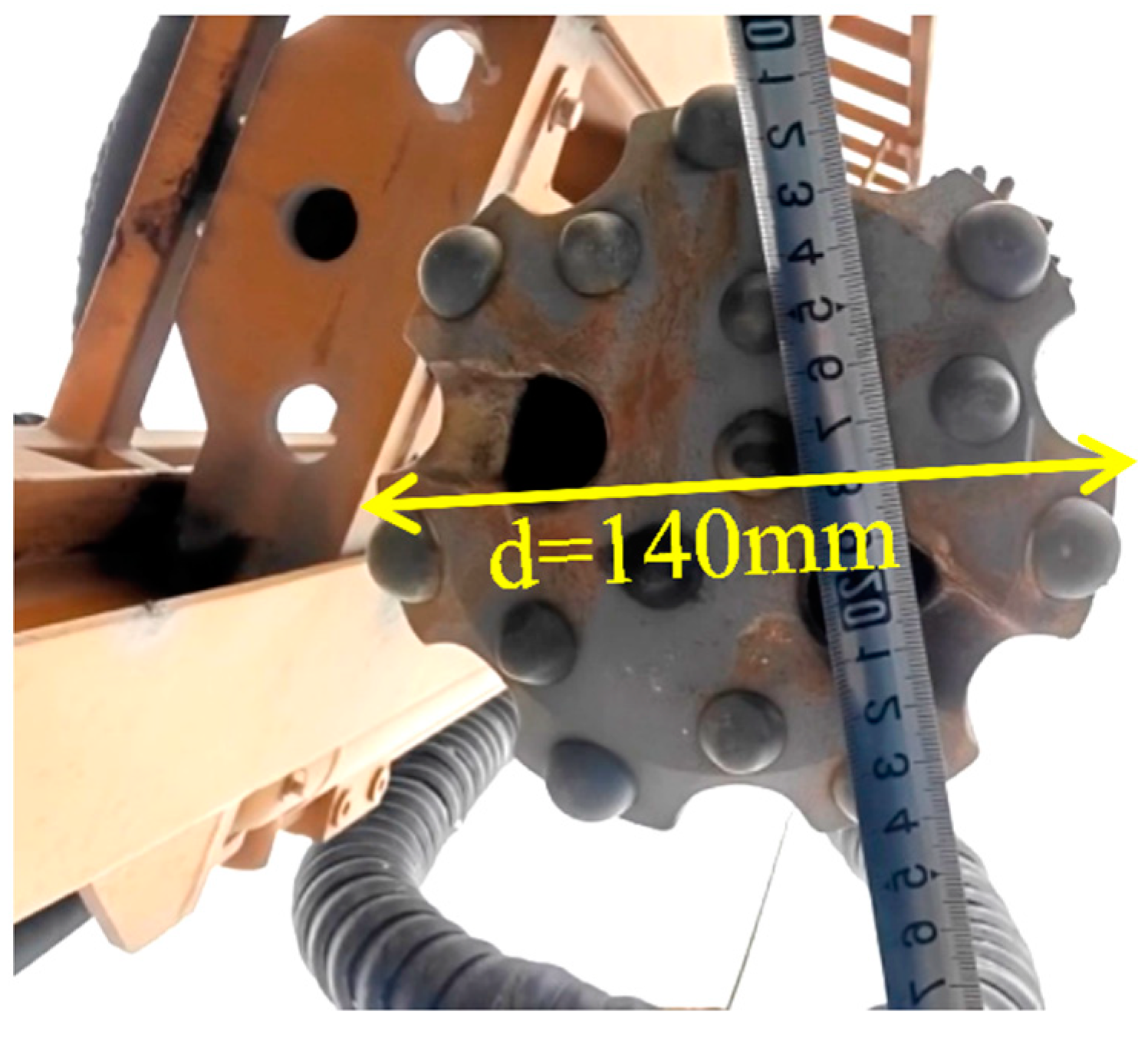

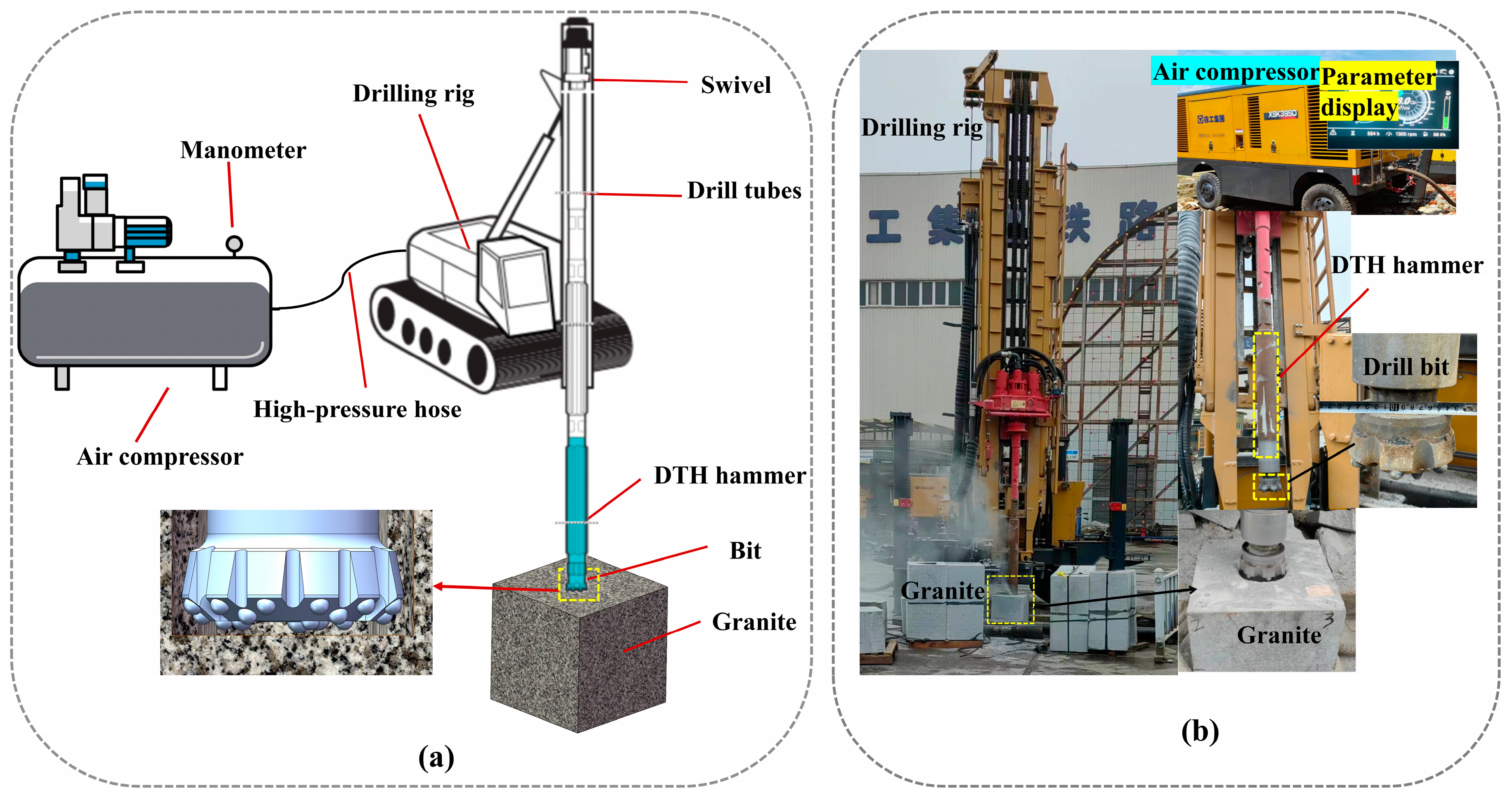

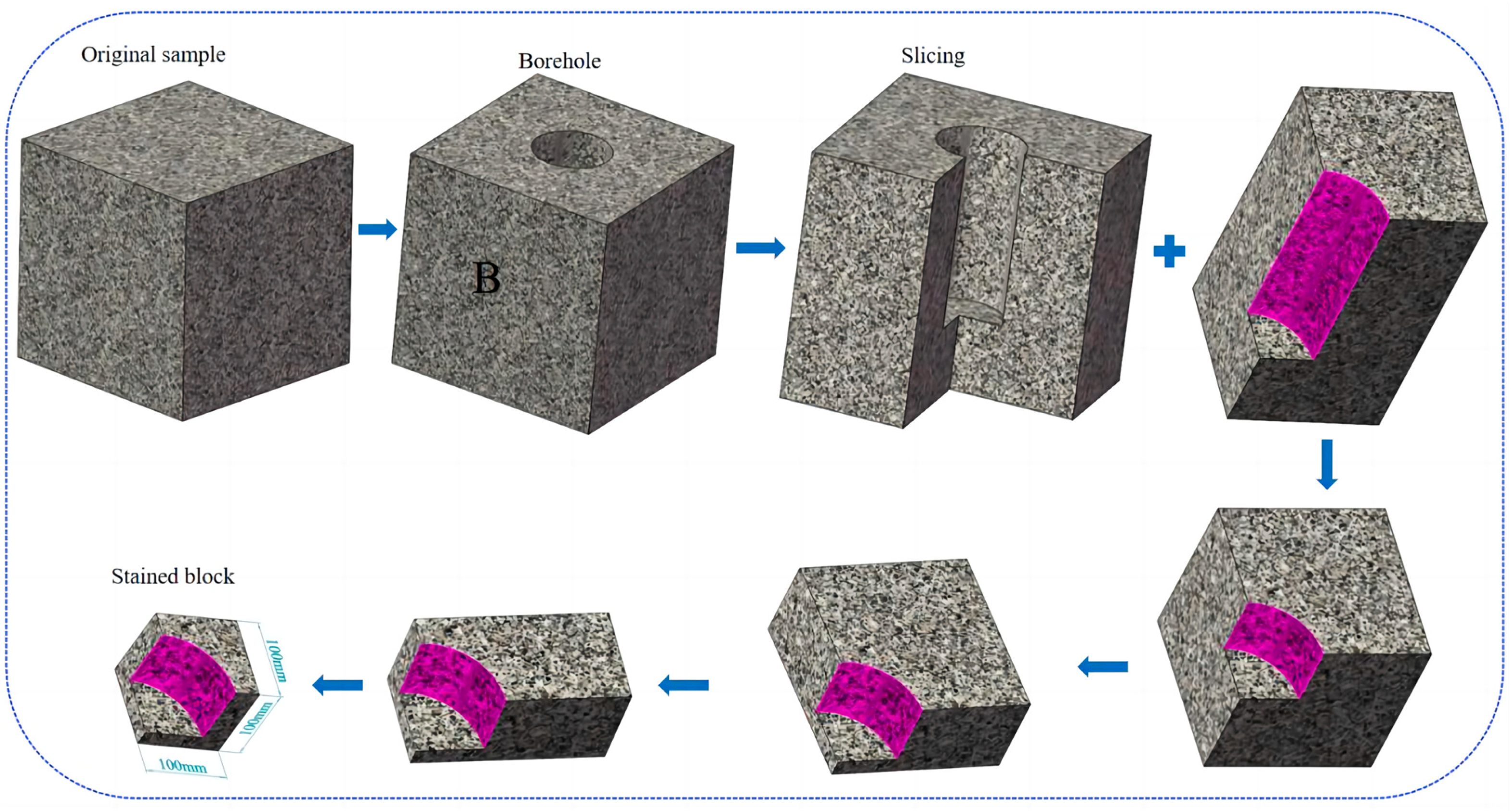
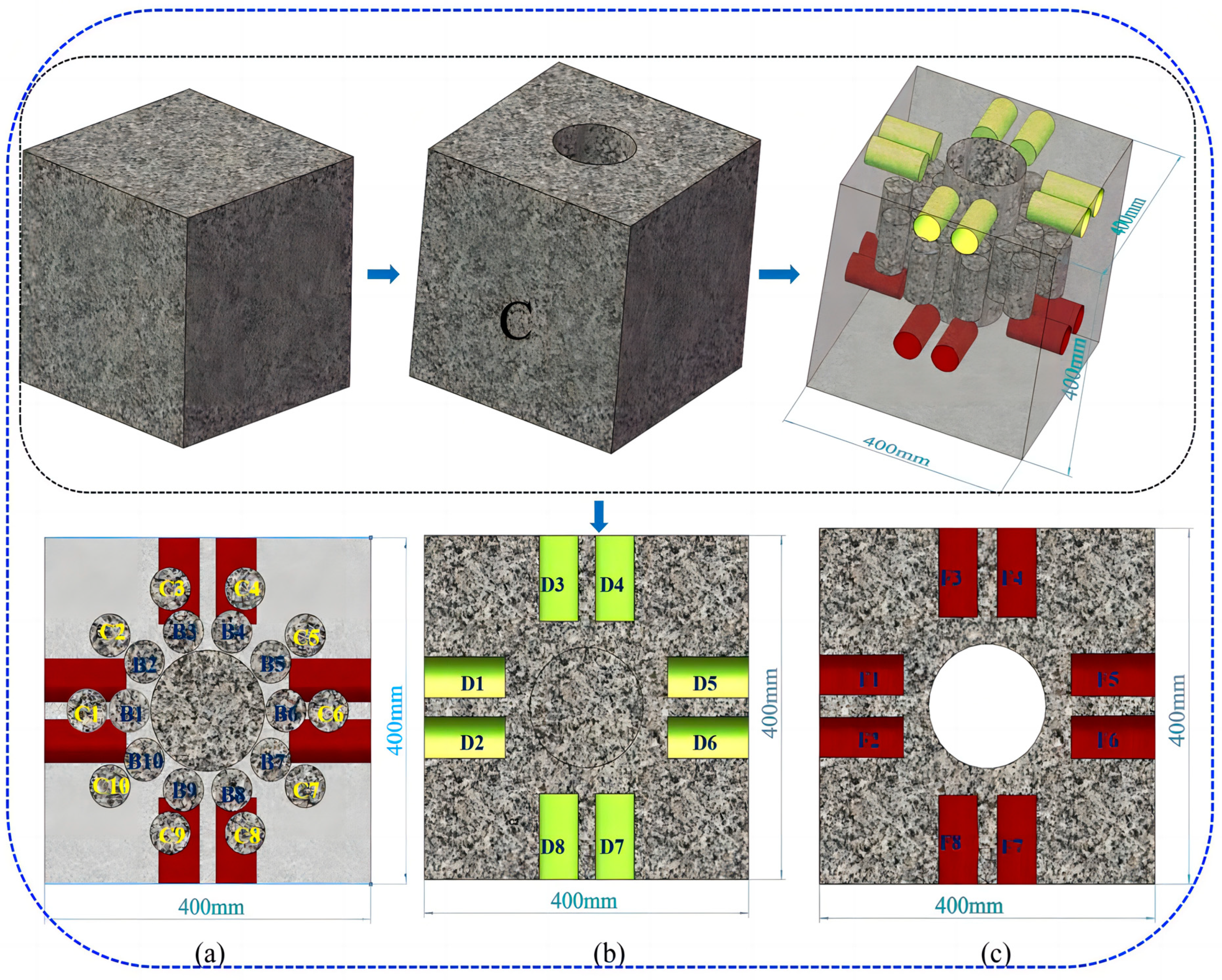

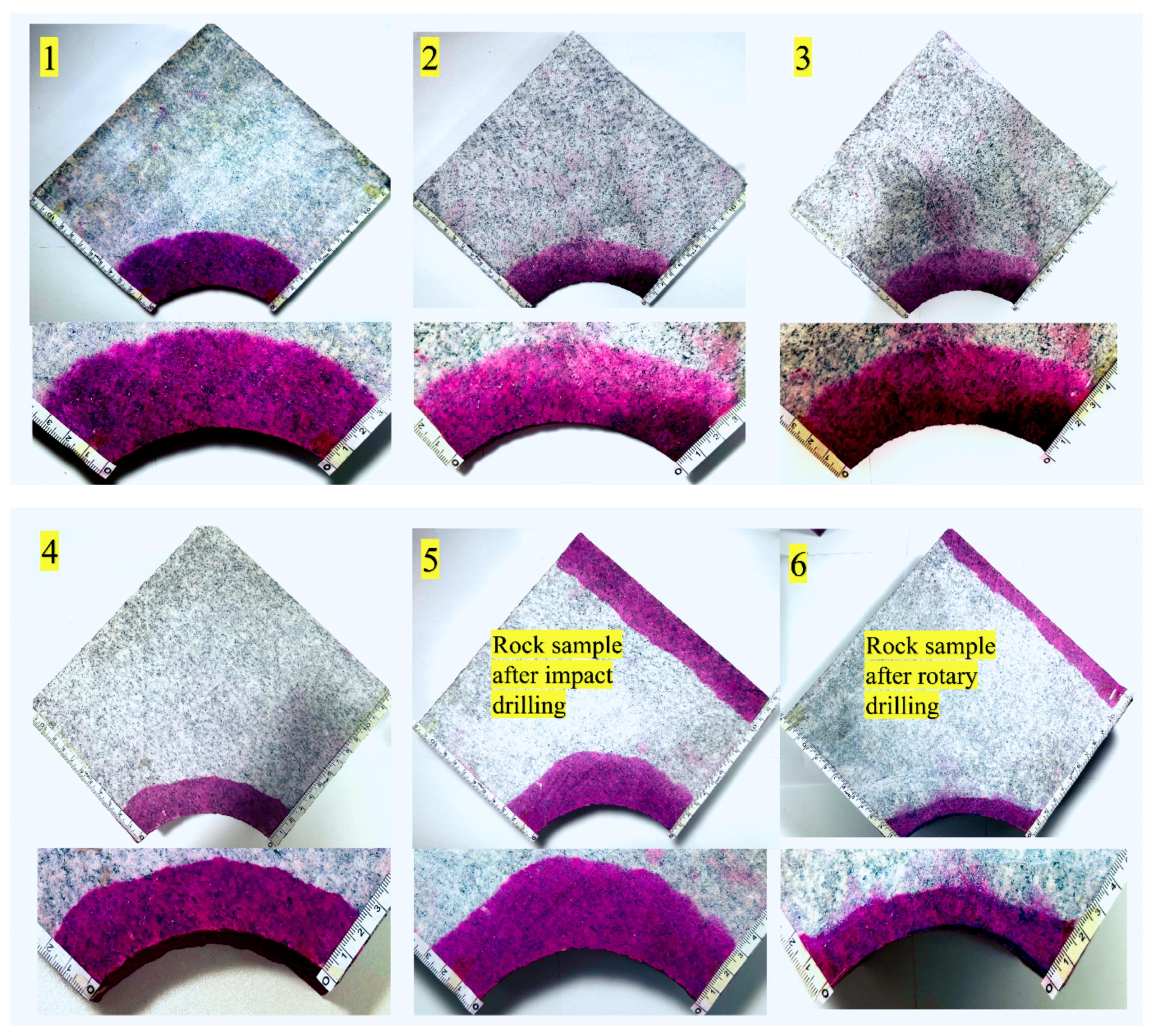
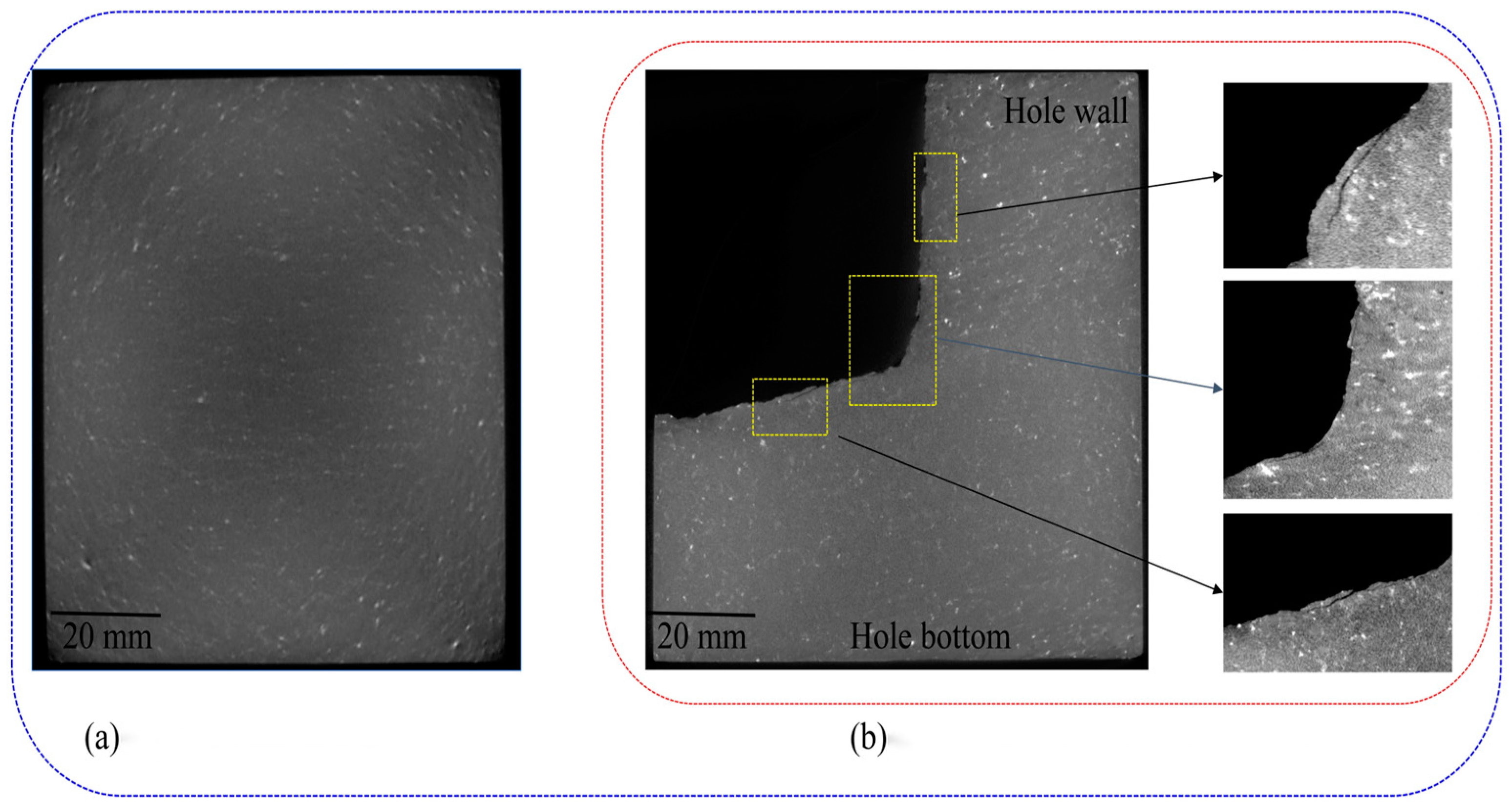

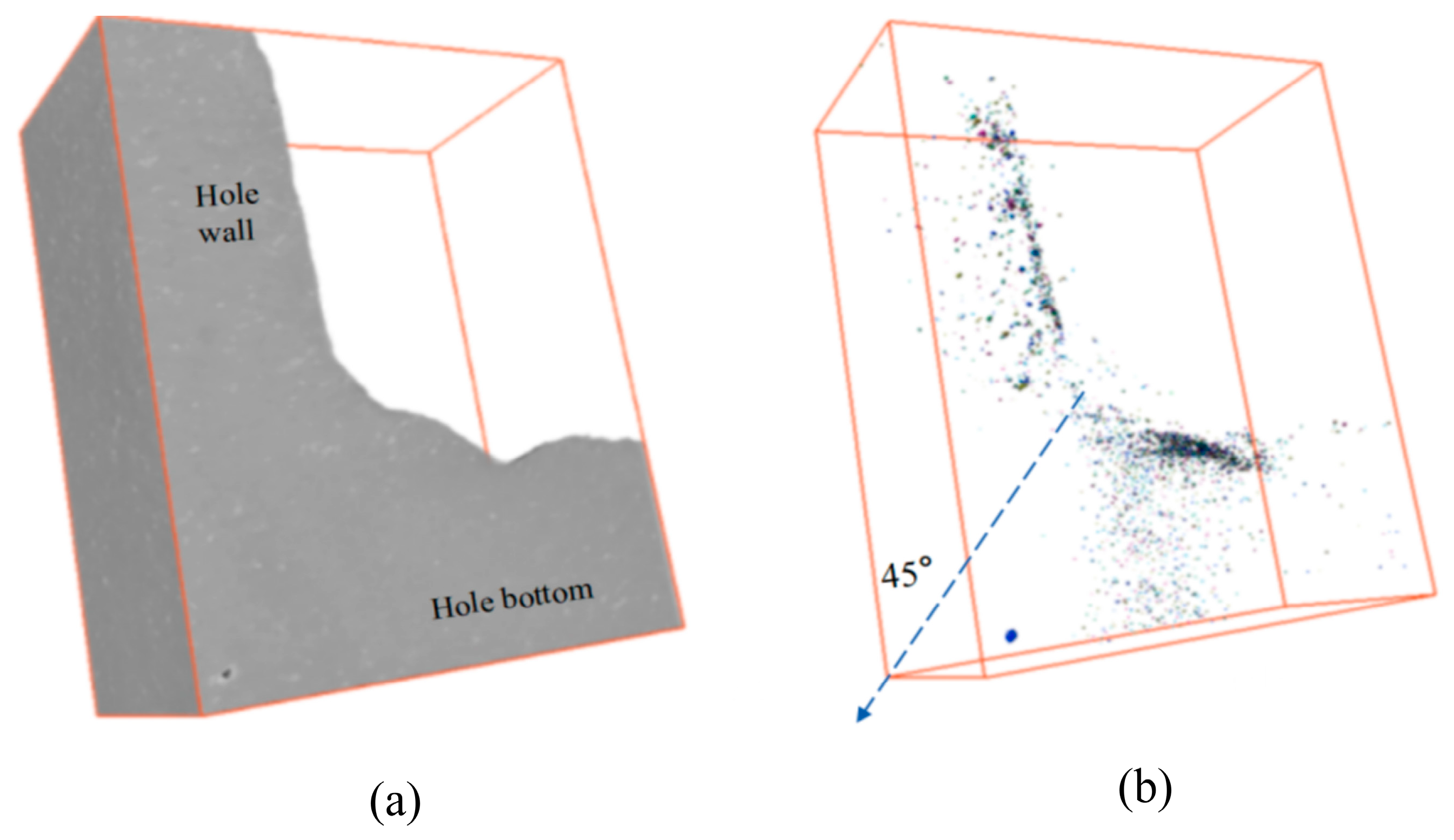



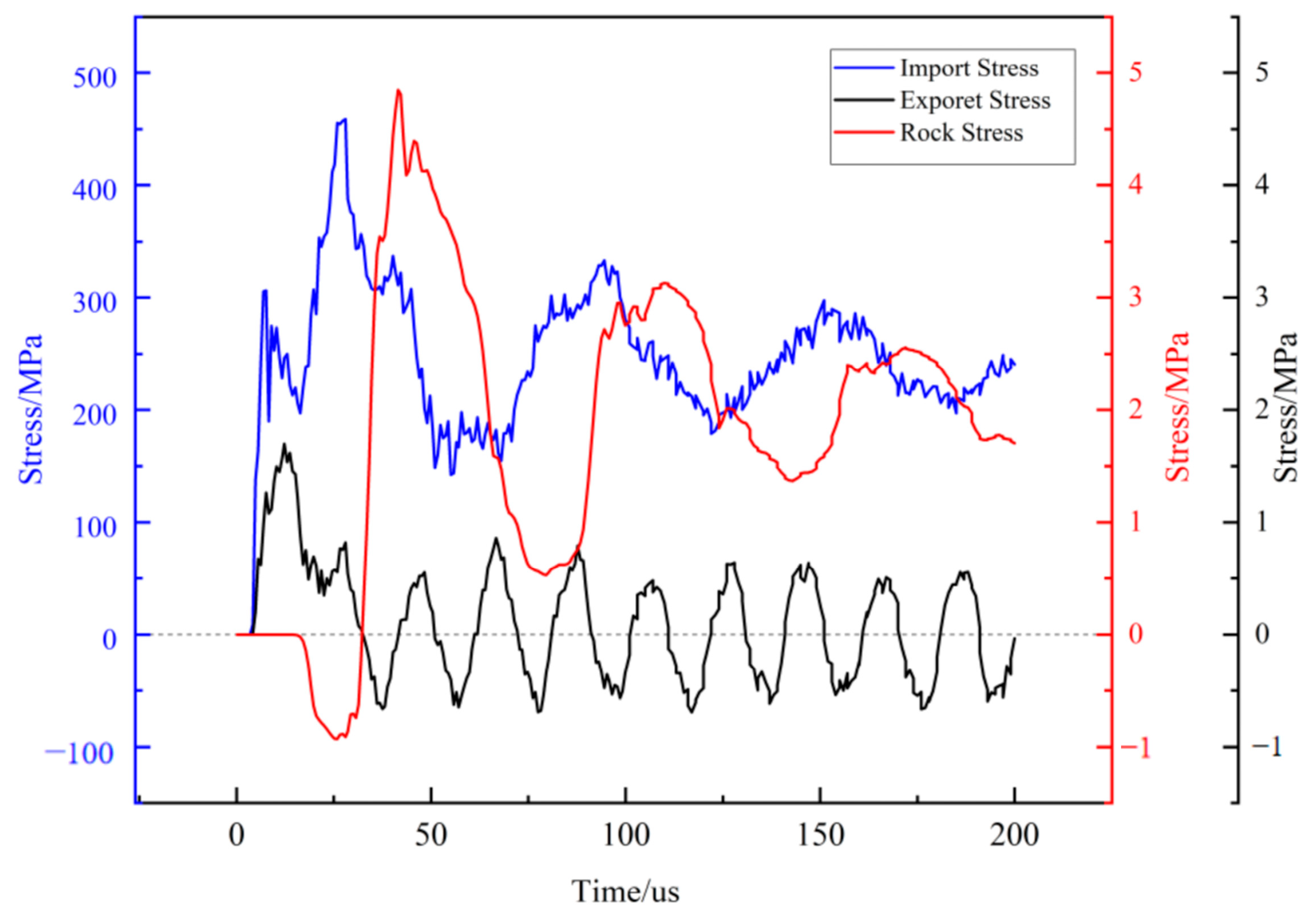
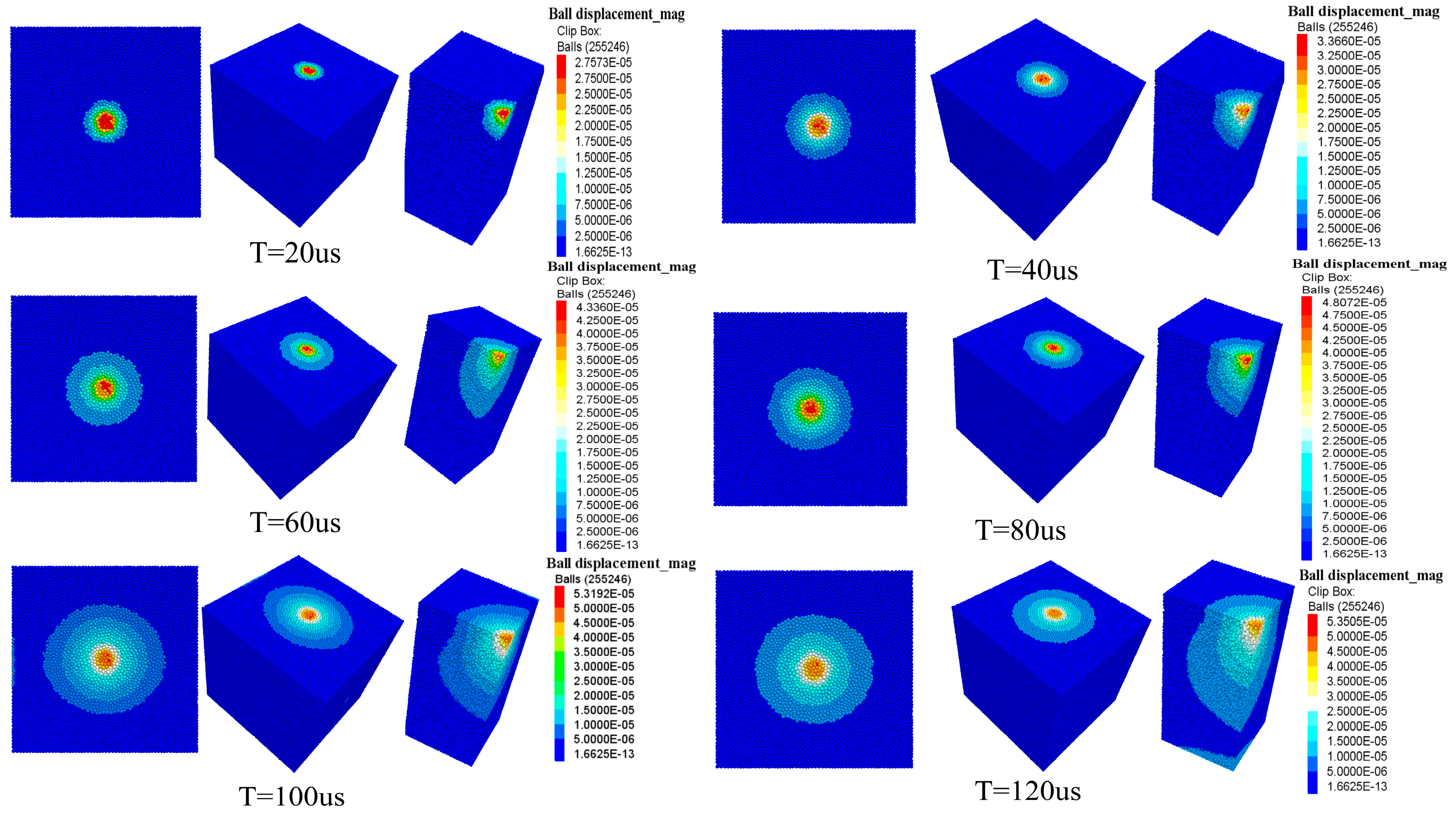
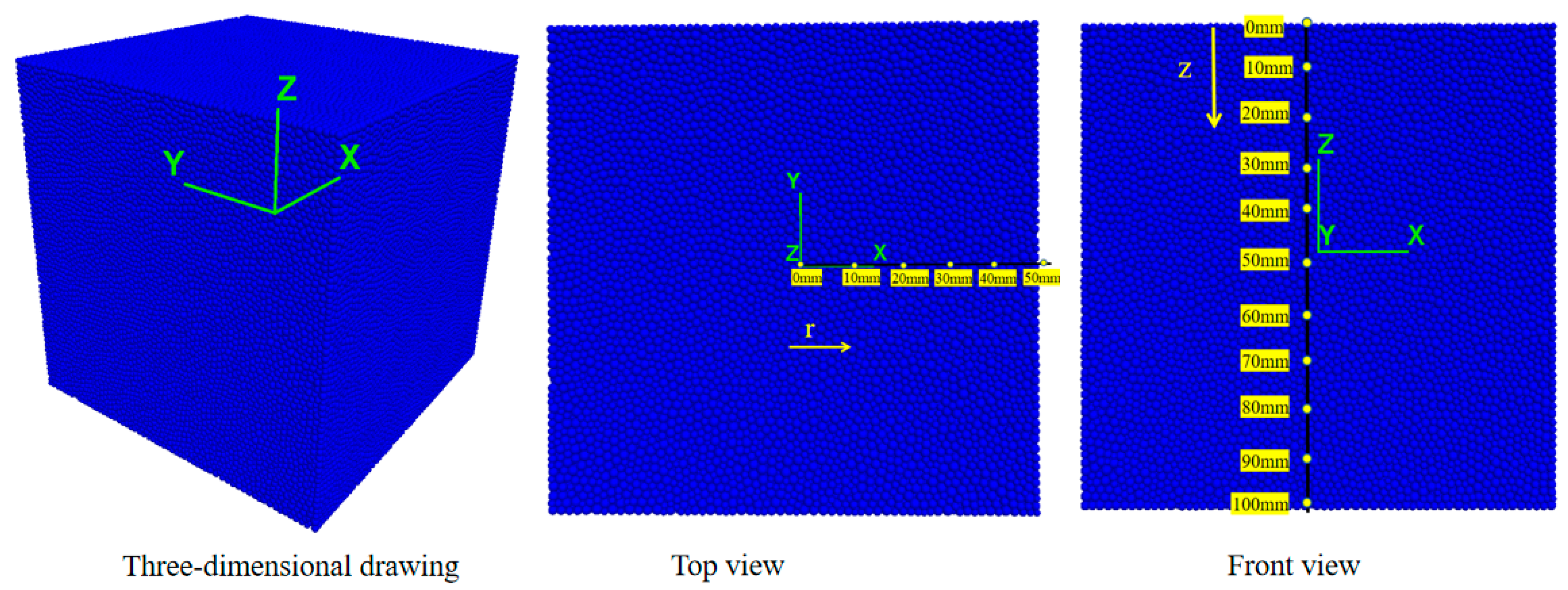



| Main Minerals | Quartz | Potassium Feldspar | Albite | Mica |
|---|---|---|---|---|
| Content | 28% | 36% | 31% | 5% |
| Mechanical Properties | Values |
|---|---|
| Density, (kN/m3) | 26.3 |
| Young’s modulus, E (GPa) | 35.6 |
| 0.23 | |
| Tensile strength, σt (MPa) | 8.91 |
| Uniaxial compressive strength, σc (MPa) | 148 |
| Friction angle, Φ (deg) | 57 |
| Porosity, % | 1.127 |
| Permeability, (mD) | 0.0546 |
| Drill Diameter (mm) | Edge Tooth Diameter (mm) | Minimum Wall Thickness (mm) | Minimum Side Length (mm) |
|---|---|---|---|
| 140 | 18 | 44.82 | 229.64 |
| Wellbore Diameter | Wellbore Depth | Weight of Bit | Weight of DTH | Pump Pressure | Input Flow | Rotation Rate | Rate of Penetration | Impact Energy | Impact Frequency |
|---|---|---|---|---|---|---|---|---|---|
| 140 mm | 260 mm | 15.3 kg | 70 kg | 1.0 MPa | 7000 L/min | 30 r/min | 10.4 m/h | 4546.52 J | 30 Hz |
| Location of Rock Samples | Sample Number | Length (cm) | Diameter (cm) | Average Compressive Strength (MPa) |
|---|---|---|---|---|
| Original rock sample | A1–A10 | 100 | 50 | 148.653 |
| Near-borehole wall rock sample | B1–B10 | 100 | 50 | 129.680 |
| Distant-borehole wall rock sample | C1–C10 | 100 | 50 | 142.027 |
| Orifice rock sample | D1–D8 | 100 | 50 | 118.990 |
| Borehole bottom rock sample | F1–F8 | 100 | 50 | 108.525 |
| Location of Rock Samples | Sample Number | Length (cm) | Diameter (cm) | Average Porosity (%) | Average Permeability (Md) |
|---|---|---|---|---|---|
| Original rock sample | A1–A3 | 4.999 | 2.457 | 1.127 | 0.0546 |
| Near-borehole wall rock sample | G1–G3 | 4.989 | 2.445 | 1.218 | 0.0911 |
| Distant-borehole wall rock sample | H1–H3 | 4.990 | 2.465 | 1.156 | 0.0589 |
| Orifice rock sample | J1–J3 | 5.491 | 2.450 | 1.191 | 0.1107 |
| Borehole rock sample | K1–K3 | 4.987 | 2.460 | 1.370 | 0.0716 |
| Micro-Parameters | Value | |||
|---|---|---|---|---|
| Mineral Properties | Quartz | Potassium Feldspar | Albite | Mica |
| Content | 28% | 36% | 31% | 5% |
| Minimum particle radius, mm | 0.06 | 0.06 | 0.06 | 0.06 |
| Particle-size ratio | 1.66 | 1.66 | 1.66 | 1.66 |
| Particle density, kN/m3 | 26.3 | 26.3 | 26.3 | 26.3 |
| Contact normal to shear Stiffness ratio (kn/ks) | 1.5 | 1.5 | 1.5 | 1.5 |
| Particle–particle contact modulus, GPa | 49 | 39 | 29 | 19 |
| Particle friction coefficient | 1.2 | 1.2 | 1.2 | 1.2 |
| Radius multiplier | 1.5 | 1.5 | 1.5 | 1.5 |
| Parallel bond normal to shear stiffness ratio | 1.0 | 2.0 | 2.0 | 1.5 |
| Parallel bond modulus, GPa | 19 | 16 | 15 | 10 |
| Parallel bond tensile strength, MPa | 25 | 23 | 21 | 20 |
| Parallel bond cohesion, MPa | 53 | 47 | 45 | 40 |
| Parameters | Experimental Value | Simulation Value | Error, % |
|---|---|---|---|
| Tensile strength, MPa | 8.93 | 9.39 | 5.2 |
| UCS, MPa | 148 | 153.6 | 4.6 |
| Elastic modulus, GPa | 20.3 | 20.89 | 2.9 |
Disclaimer/Publisher’s Note: The statements, opinions and data contained in all publications are solely those of the individual author(s) and contributor(s) and not of MDPI and/or the editor(s). MDPI and/or the editor(s) disclaim responsibility for any injury to people or property resulting from any ideas, methods, instructions or products referred to in the content. |
© 2024 by the authors. Licensee MDPI, Basel, Switzerland. This article is an open access article distributed under the terms and conditions of the Creative Commons Attribution (CC BY) license (https://creativecommons.org/licenses/by/4.0/).
Share and Cite
Tian, L.; Yang, X.; Zhang, R.; Zheng, K.; Jiang, O.; Zheng, X. Experimental and Numerical Simulation Study on the Mechanism of Fracture-Increasing and Permeability-Increasing in Granite Pore Walls by the Air DTH Hammer Percussion Drilling. Processes 2024, 12, 758. https://doi.org/10.3390/pr12040758
Tian L, Yang X, Zhang R, Zheng K, Jiang O, Zheng X. Experimental and Numerical Simulation Study on the Mechanism of Fracture-Increasing and Permeability-Increasing in Granite Pore Walls by the Air DTH Hammer Percussion Drilling. Processes. 2024; 12(4):758. https://doi.org/10.3390/pr12040758
Chicago/Turabian StyleTian, Longjun, Xinxiang Yang, Renjie Zhang, Kai Zheng, Ou Jiang, and Xiuhua Zheng. 2024. "Experimental and Numerical Simulation Study on the Mechanism of Fracture-Increasing and Permeability-Increasing in Granite Pore Walls by the Air DTH Hammer Percussion Drilling" Processes 12, no. 4: 758. https://doi.org/10.3390/pr12040758







